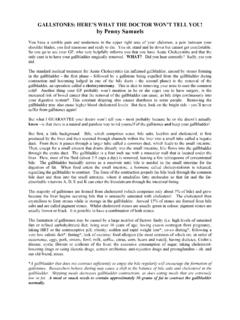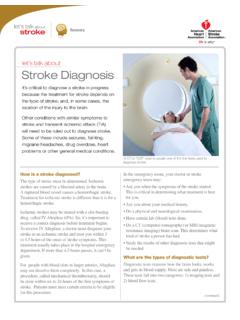Transcription of OCT Bootcamp: The Basics of Retinal OCT
1 OCT bootcamp : The Basics of Retinal OCT. Optometry Symposium Hilary Wilson, November 2, 2008. Question How many ophthalmic imaging tests can claim the following? Non-invasive Non-contact No radiation Painless Fast Reliable and sensitive (to 10 microns). Optical Coherence Tomography Diagnostic test that allows for imaging and measurement of various ocular structures OCT: Anterior Segment OCT: Optic Nerve OCT: Retina Goals Quick overview of OCT function Interpretation of macular OCT scan Define indications for macular OCT. Practical examples How does OCT work? Rays of light provide 2 and 3-dimensional imaging of tissues at histological level Optical Biopsy of Retinal Layers Limitations of Retinal OCT.
2 Mydriasis may sometimes be necessary Dioptric media must be somewhat transparent Exploration typically limited to posterior pole Good lacrimal film necessary Obtaining A Macular Scan Composite Macular Scan Interpretation of Macular OCT Printout Assessment of reliability Scan placement Signal strength Algorithm performance Scan Placement Signal Strength Signal strength 6 = adequate Signal strength 8 = very good Algorithm Performance For macular scan, the borders of algorithm should fit to ILM and PR inner and outer segment If algorithm has failed, then the quantitative data should be disregarded Interpretation of Macular OCT Printout Color-coded qualitative thickness map Interpretation of Macular OCT Printout Color-coded quantitative thickness map Macula 150 to 250.
3 Foveola 200 . Interpretation of Macular OCT Printout Table of thickness and volume parameters Indications for Retinal OCT. To examine the retina and its sub-layers Atrophy, Edema, Traction, Subretinal fluid, RPE irregularity ARMD, CME, CSME, CSR. To monitor progression To aid in treatment planning To monitor response to therapy Indications for Retinal OCT. To examine the retina and its sub-layers Extent of Retinal defects or abnormalities Detailed measurements Indications for Retinal OCT. To monitor progression Indications for Retinal OCT. To aid in treatment planning To monitor response to therapy Case Studies: Vitreoretinal Interface Disorders Case 1.
4 A 67 year-old man notes progressive decrease in vision OS x 6 mos VA 20/20 OD, 20/200 OS. Case 1 Fundus Photo Case 1 OCT of Macula Diagnosis? Case 1 OCT Macular Scan Diagnosis: Vitreomacular traction Epiretinal membrane Cystoid macular edema OCT Macular Scan: 3 Months Post-op No remaining ERM. Macular edema resolved VA 20/40. Comparison OCT: Preop & Postop OCT Advantage Enhanced visualization of pathological process Aided in determining optimal treatment Postoperative OCT showed resolution Case Studies: Retinal Vascular Diseases Case 2. 66-yo woman with severe NPDR OS. treated with focal laser photocoagulation complains of subsequent worsening vision OS x several months Her visual acuity 20/60 OD, 20/200 OS.
5 Case 2 Fundus Photo Case 2: FA Early and Late Case 2: Initial OCT - CSME. Case 2: OCT 6 wks post-IVK. Case 2: Pre- and Post-Treatment Case 2 OCT Advantage Quantified morphological abnormality Showed failure to respond to original laser treatment Showed improvement with adjunctive intravitreal therapy Case Studies: Other Retinal Entities Case 3. A 75-year-old woman complains of slowly deteriorating vision OS over 6 months VA 20/30 OD, 20/60 OS. Case 3: Fundus Photo Case 3: FA Early and Late Case 3: OCT. Diagnosis Case 3: OCT. Diagnosis: Wet ARMD with occult CNVM. Case 3 OCT Advantage Effectively demonstrates the layers involved in the pathological process Case 4.
6 A 70-year-old male was referred for evaluation of persistently decreased central visual acuity OD after Retinal detachment repair 3 months earlier VA remained 20/200 OD. Case 4 Fundus Photo Case 4 OCT. Case 9 OCT Advantage Diagnosis? Case 9 OCT Advantage Persistent shallow RD. Case 4 OCT Advantage Reveals structural defect that is difficult to identify ophthalmoscopically Unexpected Uses Retinitis Pigmentosa Angioid Streaks Summary Retinal OCT as useful diagnostic tool for: Evaluating structural integrity of posterior pole Decision making Following sequential change References Schuman, J, Puliafito, C. and Fujimoto, James.
7 Everyday OCT. Slack. 2006. Nussenblat, RB, Kaufman, SC, Palestine, AG, Davis, MD, Ferris, FL. (1987) Macular thickening and visual acuity Ophthalmology 94,1134-1139. Hee, MR, Puliafito, CA, Duker, JS, et al (1998) Topography of diabetic macular edema with optical coherence tomography Ophthalmology 105,360-370. Chauhan, DS, Marshall, J. (1999) The interpretation of optical coherence tomography images of the retina Invest Ophthalmol Vis Sci 40,2332-2342. Koozekanani, D, Roberts, C, Katz, SE, Herderick, ED. (2000) Intersession repeatability of macular thickness measurements with the Humphrey 2000 OCT Invest Ophthalmol Vis Sci 41,1486-1491.
8 Munuera, JM, Garc a-Layana, A, Maldonado, MJ, Aliseda, D, Moreno-Monta s, J. (1998) Optical coherence tomography in successful surgery of vitreomacular traction syndrome Arch Ophthalmol 116,1388-1389. Hee, MR, Puliafito, CA, Wong, C, et al (1995) Quantitative assessment of macular edema with optical coherence tomography Arch Ophthalmol 113,1019-1029. Otani, T, Kishi, S, Maruyama, Y. (1999) Patterns of diabetic macular edema with optical coherence tomography Am J Ophthalmol 127,688-693.. Early Treatment Diabetic Retinopathy Study Research Group (1991) ETDRS report number 7: Early Treatment Diabetic Retinopathy Study design and baseline patient characteristics Ophthalmology 98,741-756.
9 Puliafito, CA, Hee, MR, Lin, CP, et al (1995) Imaging of macular diseases with optical coherence tomography Ophthalmology 102,217-229. Thank You Any Questions?







